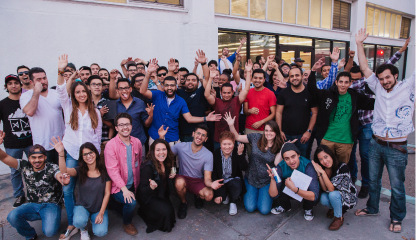Your Future as a Graphic Designer: Merging Talent and Technical Acumen
If you’re considering a career in graphic design, you probably already know that it’s a vast and exciting field, and the opportunities are as varied as the industry itself. In the advent of Social Media and our ever-increasing dependency on technology, there are no signs of stopping in the world of graphic design. Whether you’re considering a position as a drafter in the printing or digital field, or an art director specializing in marketing, there’s no shortage of careers once you’ve met your graphic design degree requirements. As a career path with so many options to choose from, it’s important to know the appropriate steps to take when planning for college coursework and related studies.
Becoming a successful graphic designer is a culmination of many skill sets. In addition to your creative abilities, technological skills are mandatory, as you’ll be responsible for learning a wealth of software programs, including but not limited to Adobe InDesign, Quark, and Photoshop on the design end, as well as HTML and CSS on the development end. The more proficient you are in both spectrums, the more desirable you will become in the job market. Additionally, the ability to multitask goes beyond the artistic or digital scope:
Interpersonal skills are a key element of your day-to-day interactions, as you’ll often work within a team setting. Consequently, a career in this industry appeals to a broad demographic – depending on your specific skill set and background. Try to fine-tune your particular niche and determine the best job opportunities in graphic design to suit your long-term goals.
Graphic Designer Job Description
Before jumping into what the graphic design requirements are, it’s important to discuss what being a graphic designer entails. Graphic designers are responsible for creating visual concepts, using computer software or by hand to help support a client’s brand. The goal is to convey a message that inspires, informs, and captivates consumers. Projects a graphic designer works on can range from a simple logo design to a complete campaign package. Two- or three-dimensional art are used to execute visual concepts for their marketing materials. This can be done through advertisements, emails, websites, brochures, magazines, annual reports, and much more.
Duties of a Graphic Designer
Graphic designer duties include the following:
- Meet with clients or creative director of a company to determine the vision and scope of a project
- Be able to incorporate changes recommended by the clients or the art directors into the final design
- Present design concepts to clients or the art directors
- Design layouts and select colors, typography, image, and typefaces to help support a clients brand
- Use digital illustration, photo editing software, and layout software to create a design
- Create visual elements such as logos, original images, and illustrations to carry out the desired message
- Review designs for errors before printing or publishing them
- Test graphics across various media
- Maintain technical knowledge by attending design workshops; reviewing professional publications; and participating in professional societies
Work Environment for Graphic Designers
Graphic designers generally work in studios, where they have access to equipment such as software, computers, and drafting tables in order to create their designs. Many graphic designers work independently. Self-employed graphic designers have the freedom to create a studio or office that is comfortable and inspirational. Freelance designers are required to work as many hours are necessary to meet client deadlines and goals. However, those who work for specialized graphic design firms are often part of a design team. A large portion of graphic designers collaborate with colleagues or work with clients on projects.
The largest employers of graphic designers are as follows:
- Self-employed workers 21%
- Specialized design services 10%
- Advertising, public relations, and related services 8%
- Printing and related activities 7%
- Newspaper, periodical, book, and directory publishers 5%
How to Become A Graphic Designer: A Helpful Guideline
If you are interested in pursuing a career in graphic design, you’ll want to explore the graphic design requirements carefully for your college coursework – your classes and internships may vary a great deal, depending on the particular type of job you’re looking for upon graduation. However, there are certain rules of thumb that will apply universally to this area of expertise. Below, some general guidelines to keep in mind when planning your education.
Graphic Designer Education: Earning Your Bachelor’s Degree
As is customary in most specialized industries, a bachelor’s degree in Graphic Design or a related field is required for job placement. However, candidates with a bachelor’s degree in another field may obtain technical training in graphic design to meet most hiring specifications. High school students who are considering a graphic design major should take basic computer, design, and art courses in high school if available. Also, they should start to put their portfolios together in preparation for college admission. It’s important to speak with guidance counselors and department heads for more information, as each college has different requirements for application, including portfolio review and specifications.
Once you have been accepted to the institution of your choice, it is important to maintain and build your portfolio throughout your college education – this is a crucial tactic for finding employment. Potential employers depend on a well-executed portfolio that embodies your unique talent to determine if you’re a good fit for their company. In addition, it’s key to stay abreast of current trends in the industry – from new developments in design software to updated computer graphics, you’ll need to stay up to date to maintain an edge on the competition.
Professional Experience
Most graphic designers gain on-the-job experience via internships, either during their college coursework or shortly after graduating. Such opportunities provide aspiring designers the chance to work with seasoned industry professionals while gaining the necessary skills to hone their craft. In addition, earning certifications and licenses in different software programs is advantageous to prospective job seekers.
The following qualities are also essential for anyone seeking a successful career in graphic design:
- Analytical Skills: As a graphic designer, your ability to view your work from a consumer perspective is fundamental – having a deep understanding of the demographic you’re designing for is key when conveying a client or employer’s branded message, image and/or design aesthetic.
- Artistic Abilities: Your role as a graphic designer typically centers around the visual image: creating unique designs that are appealing to a mass audience as well as your client. Through drawings, sketches and design software, your responsibilities will involve some form of artistic medium aimed at capturing the vision and story of your client.
- Communication Skills: In order to interact cohesively within a team setting and convey ideas succinctly and effectively, excellent communication skills are required. Your responsibilities will entail communicating with other designers, programmers, IT, web developers, customers, clients and other professionals on a daily basis.
- Computer Skills: As discussed earlier, an advanced knowledge of computer software and specialized programs is a requirement for any professional graphic designer.
- Creativity: Thinking ‘out of the box’ is one of the primary elements to any creative field, and this holds particularly true in the world of graphic design. As an ever-evolving industry encompassing elements of fine art, computer graphics, marketing savvy, and communication through digital imagery, among others, your innate creativity is one of the most notable skills to keep in mind when considering this career path.
- Time Management: If you wish to excel in this field, it’s important to possess excellent time-management skills, as graphic designers are often responsible for multiple projects simultaneously once they are in the workforce.
Top 7 Graphic Design Careers to Explore
As outlined above, many specialized careers fall under the ‘Graphic Designer’ category – therefore, it’s important to determine which direction you wish to pursue in the job market, based on your skillset, interests, and professional goals. Here is a list of some of the hottest career paths in the world of graphic design:
- Advertising, Promotions and Marketing Manager
- Art Director
- Desktop Publisher
- Industrial Designer
- Multimedia Artist and Animator
- Technical Writer
- Web Developer
For more information, please contact NewSchool of Architecture & Design’s Enrollment Team for a complete description of each career and related coursework.








 619-684-8800
619-684-8800

